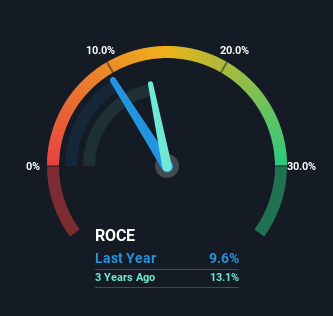Returns On Capital Signal Tricky Times Ahead For U.S. Physical Therapy (NYSE:USPH)
If you're looking for a multi-bagger, there's a few things to keep an eye out for. One common approach is to try and find a company with returns on capital employed (ROCE) that are increasing, in conjunction with a growing amount of capital employed. If you see this, it typically means it's a company with a great business model and plenty of profitable reinvestment opportunities. However, after briefly looking over the numbers, we don't think U.S. Physical Therapy (NYSE:USPH) has the makings of a multi-bagger going forward, but let's have a look at why that may be.
What Is Return On Capital Employed (ROCE)?
If you haven't worked with ROCE before, it measures the 'return' (pre-tax profit) a company generates from capital employed in its business. Analysts use this formula to calculate it for U.S. Physical Therapy:
Return on Capital Employed = Earnings Before Interest and Tax (EBIT) ÷ (Total Assets - Current Liabilities)
0.096 = US$69m ÷ (US$796m - US$85m) (Based on the trailing twelve months to June 2022).
So, U.S. Physical Therapy has an ROCE of 9.6%. On its own, that's a low figure but it's around the 11% average generated by the Healthcare industry.
View our latest analysis for U.S. Physical Therapy
In the above chart we have measured U.S. Physical Therapy's prior ROCE against its prior performance, but the future is arguably more important. If you'd like, you can check out the forecasts from the analysts covering U.S. Physical Therapy here for free.
What Can We Tell From U.S. Physical Therapy's ROCE Trend?
On the surface, the trend of ROCE at U.S. Physical Therapy doesn't inspire confidence. Over the last five years, returns on capital have decreased to 9.6% from 13% five years ago. However, given capital employed and revenue have both increased it appears that the business is currently pursuing growth, at the consequence of short term returns. And if the increased capital generates additional returns, the business, and thus shareholders, will benefit in the long run.
In Conclusion...
In summary, despite lower returns in the short term, we're encouraged to see that U.S. Physical Therapy is reinvesting for growth and has higher sales as a result. In light of this, the stock has only gained 33% over the last five years. So this stock may still be an appealing investment opportunity, if other fundamentals prove to be sound.
Like most companies, U.S. Physical Therapy does come with some risks, and we've found 2 warning signs that you should be aware of.
While U.S. Physical Therapy isn't earning the highest return, check out this free list of companies that are earning high returns on equity with solid balance sheets.
Have feedback on this article? Concerned about the content? Get in touch with us directly. Alternatively, email editorial-team (at) simplywallst.com.
This article by Simply Wall St is general in nature. We provide commentary based on historical data and analyst forecasts only using an unbiased methodology and our articles are not intended to be financial advice. It does not constitute a recommendation to buy or sell any stock, and does not take account of your objectives, or your financial situation. We aim to bring you long-term focused analysis driven by fundamental data. Note that our analysis may not factor in the latest price-sensitive company announcements or qualitative material. Simply Wall St has no position in any stocks mentioned.
Join A Paid User Research Session
You’ll receive a US$30 Amazon Gift card for 1 hour of your time while helping us build better investing tools for the individual investors like yourself. Sign up here

